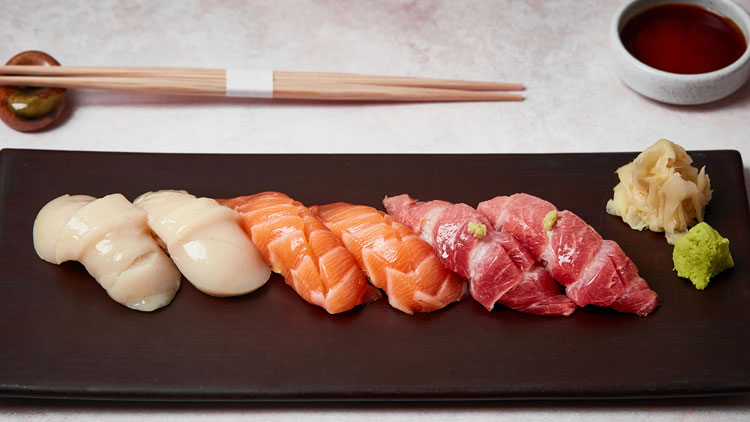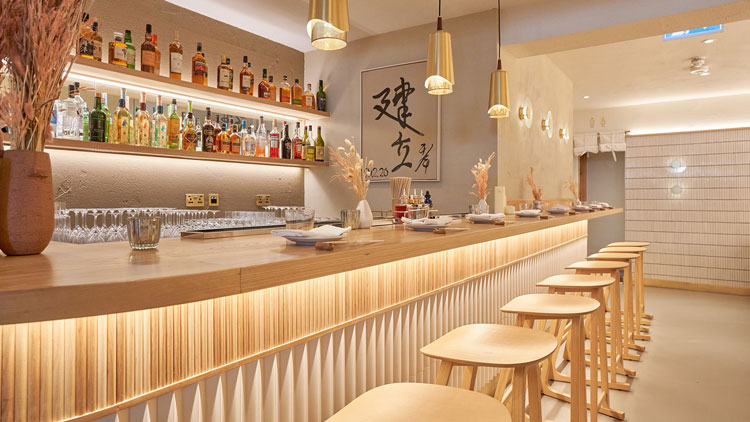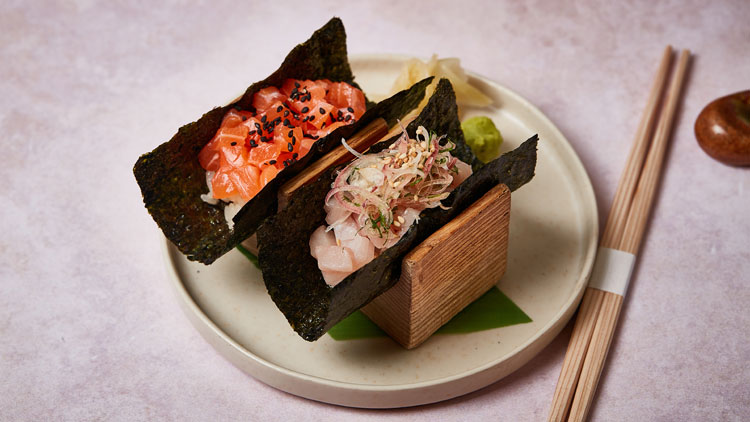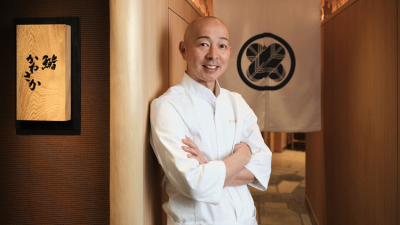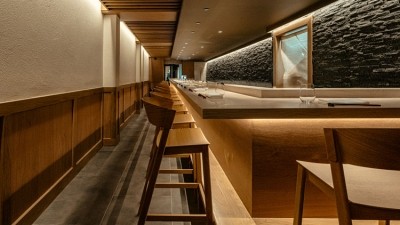SUMI’s Endo Kazutoshi and Christian Onia have established a ‘middle space’ in sushi
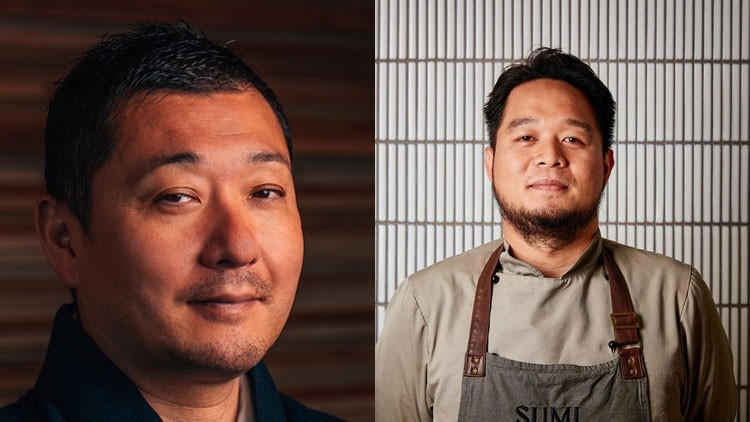
It’s early lunchtime in London’s Notting Hill, and already the dining room at SUMI is starting to fill. First a couple enter; followed by a few smaller groups. Later, a couple of solo diners take up tables, each after a quick sushi fix; and then a large group of seven or eight people arrive – friends who have clearly not seen each other in ages, ready to reminisce over a good meal.
Within half an hour of the lunch service starting, the restaurant is best part full. There’s a relaxed excitement in the room as plates of edamame and seaweed salad make way for temaki and nigiri before moving onto hot plates, many of which are prepared on the robata grill. Launched last summer by third-generation sushi master Endo Kazutoshi, SUMI is the more informal sister to the chef’s high-end omakase restaurant Endo at the Rotunda in Shepherd’s Bush.
From the beginning, the restaurant has proven popular. The Evening Standard’s Jimi Famurewa described it as ‘packing familiar comforts for a sushi-literate audience, but also dealing in some curveballs too’. Getting a table was a hotly contested affair, and it still is, but things have now been made easier thanks to the acquisition of the restaurant’s neighbouring unit that has seen covers in the dining room rise from 45 to 61 and an additional 70m2 of floor space added.
At the same time there’s also been an overhaul in the kitchen, with former Roka and Sosharu chef Christian Onia taking over the stoves. Despite only being a year old, SUMI has undergone some significant changes recently. But, in many ways, much of the restaurant remains the same.
How did the opportunity to expand the restaurant come about?
Endo Kazutoshi: We were approached by the owners of the restaurant next door to us, who said they were looking to sell. I spoke to my partner, and we thought it would be a good opportunity for the restaurant to grow. We originally envisaged SUMI as a small restaurant; it was never something we planned to make bigger, but it was very busy and we wanted to create space so we could welcome more guests to experience it.
How long had you originally been working on the idea for SUMI?
EK: I had been thinking about it before the pandemic. My restaurant at Rotunda is always fully booked, and I wanted to do something more relaxed to complement it - no omakase menu, just à la carte. I’ve spent a lot of time in the US and there’s a lot of restaurants like this over there, but in London you find sushi restaurants that are either very high end or very casual. There’s no established middle space, and that was something I wanted to explore. It’s a neighbourhood restaurant, but it’s also perfect for special occasions. We wanted to satisfy both needs.
What were the biggest challenges during SUMI’s first year?
EK: Having a small space with high demand has been tough. We opened during lockdown, which in itself was a difficult time. But we’ve been fortunate to be busy from the beginning, which we’re now able to manage better thanks to the expansion. And with Christian coming on board, it’s allowed us to expand the menu. In the beginning we got complaints that it was too small, so now we have space to develop and evolve the food offer.
How has the menu evolved?
Christian Onia: Nearly three quarters of our customers are regulars and people often pop in just for a few dishes. The sushi, in particular, is very popular, so I didn’t want to change that. But other areas have given me space to do new things, particularly the hot plates section. We’ve added three dishes, including a seafood gohan; and an Ibérico pork dish. We’ve also added a kombu-aged ribeye, which is unique. Kombu is an old technique that’s usually used with fish. We cure the meat for two days using salt and kombu seaweed, which pushes the umami out a bit, so it looks and tastes like a dry-aged meat. We have plenty of ideas like that to explore, but it’s about making sure the dishes fit with the restaurant’s concept.
Unlike at the Rotunda, SUMI has never had offered an omakase menu. Why is that?
EK: That’s why I opened this kind of restaurant. There are so many places that claim to be omakase restaurants, but so many misunderstand what it means. It’s doesn’t mean ‘chef’s choice’; it means ‘leave to the chef’. It’s about the guest allowing themselves to be left in the chef’s hands. The chef has to consider everything, from what the drink pairing is to what hand is used to place the sushi in front of the guest. Omakase now is the chef makes the food, and the guest just accepts this. It’s a buzzword to some, but for me it’s important to think about every element of the guest’s experience. They are giving you their time, and you have to know what they want and how they want it. Here the menu is à la carte, but we apply that same approach and spirit to what we do.
Inflation is driving up prices. As a business that already has a high-end price point, how do you navigate this?
EK: It’s tough and you need to work with your suppliers. We get a lot of our fish from Cornwall, and if I was to push down on the price they charge by too much then how would they be able to keep going? We have to look after them, as we rely on them. And we also have to consider our own margins and the limit of what our customers can pay. It’s harder now than ever before to make it work, but we just have to find a way.
Are you working on any future plans at the moment?
EK: I’m quite old now, so my focus is mainly on bringing up and developing the next generation of sushi chefs. We’ve brought in Christian to run SUMI and he’s fantastic. I have some involvement in the menu development, but I want this to first and foremost feel like his restaurant, with me there to support him as he needs it.
CO: Staffing is another tough area. For SUMI, we’re looking for people with good character; someone who wants to invest in their work and push themselves. It’s really hard to find chefs at the moment and even harder to find good ones, but with the knowledge we have, we’re always open to teaching and guiding new chefs. Because if we don’t do it, no one will. It’s passing the torch, basically.
